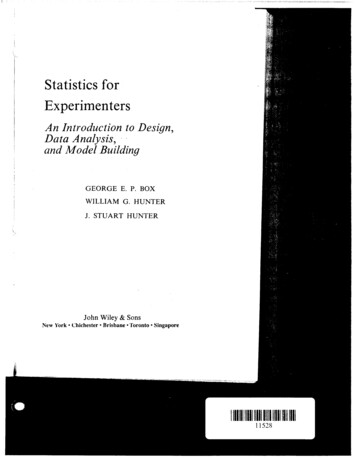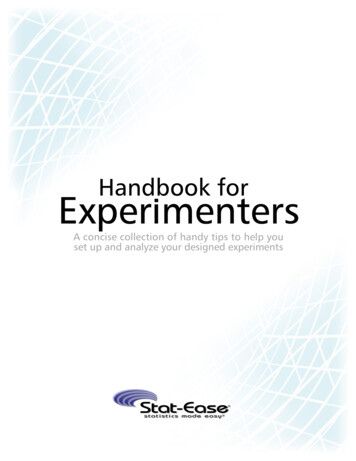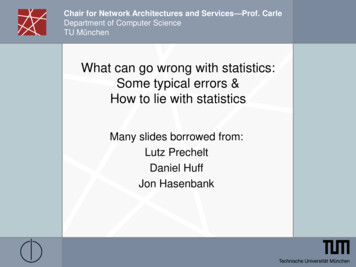
Transcription
I,Statistics forExperimentersAn Introduction to Design,Data Analysis, · ·and Mode/ BuildingGEORGE E. P. BOXWILLIAM G. HUNTERJ. STUART HUNTERJohn Wiley & SonsNew York Chichester Brisbane Toronto Singapore1111111111111111111111111111111111111528
T:01inFtthofas·cha besceiEMEst stsof!Aritorsurre prethesiotIn Eth (witTheeaci11ldtt1e\,Copyright 1978 by John Wiley & Sons, Inc.soxprac'All rights reserved. Published simultaneously in Canada.en tilllu neacthdtheir11ga siooserieReproduction or translation of any part ofthis work beyond that permitted by Sections107 or 108 of the 1976 United States CopyrightAct without the permission of the copyrightowner is unlawful. Requests for permissionor further information should be addressed tothe Permissions Department, John Wiley & Sons, Inc.ods)lrilnSl)uildAbolGEOtessoWis iPhD.IICS fAHonoRocheIH!IlGEBnllstLibrary of Congress Cataloging in Publication DataBox, George E. P.Statistics for experimenters.(Wiley series in probability and mathematicalstatistics)Includes index.I. Experimental design. 2. Analysis ofvariance. I. Hunter, William Gordon, 1937joint author. II. Hunter, J. Stuart, 1923joint author. III. Title.QA279.B68001.4'24ISBN 0-471-09315-777-15087Printed in the United States of America20 19 18 17 16 15 14 13
\ TMENT MEANS'2iyl- Yllth of the vectorvith y. Thus91ich we routinelyd y. Notice that,uiangular lineact y is obtained1lar line.nsistent nonzero1(to/Fn J) . the equiangularvel is small.4], yielding theuch larger anglenee probability.·ts [3.9, 4.1, 4.0].69, 63.9 , 0.28).t lmountsak mallan elements of the· such errors thea sphere drawnr thesphere ande. The requireda fraction of thee surface area of203MULTIPLE COMPARISONSand y - yare orthogonal and consequently Pythagoras' theory applies. The degrees offreedom indicate the number of dimensions in which the vectors are free to move. Thusbefore the data are collected the vector y is unconstrained and has n 3 degrees offreedom; the vector y, which has elements (ji, ji, ji) and is constrained to lie on the equiangular line, has only 1 degree of freedom; the vector y - y, which is constrained to lieon a plane perpendicular toy, has n - I 2 degrees of freedom. The analysis of varianceof Table 6B.2 conveniently summarizes these facts.In general, each statistical model discussed in this book determines a certain line,plane or space on which if there were no error the data would have to lie. For the exampleof this section, for instance, the model is y . Thus, without the errors , thedata would have to lie on the equiangular line at some point [ , . ]. The t and Fcriteria measure the angle that the actual data vector, which is subject to error, makeswith the appropriate line, plane and space dictated by the model. The correspondingtables indicate probabilities that angles as small or smaller will occur by chance. Theseprobabilities are dependent on the dimensions of the model and of the data through thedegrees of freedom in the table.GeneralizationThe vector breakdown of Table 6.6 for the general one-way analysis of variance is adirect extension of that of Table 6B.2. The analysis of variance of Table 6.3 is a directextension of that of Table 6B.l. The geometry and resulting distribution theory for thegeneral case is essentially an elaboration of that given above.APPENDIX 6C.MULTIPLE COMPARISONSFormal procedures for allowing for the effect of selection in making comparisons havebeen the subject of considerable research (see, e.g., O'Neill and Wetherill, 1971, andMiller, 1977, also the references listed therein).Confidence Interval for a Particular Difference in MeansA confidence interval for the true difference between the means of, say, the pth and qthtreatments may be obtained as follows. The observed difference jiP - ji9 has variance2a 2 (1/nP 1/n9 ), and a 2 is estimated by the within-treatment mean square s Thusthe estimated variance of jiP - ji9 is s2(1/nP 1/n.), and a confidence interval for thissingle preselected difference is provided by(6.CI)26B.l indicating: components ywhere v vR, the degrees of freedom associated with s .For the example discussed in this chapter, a confidence interval for the true differencebetween the means of treatments A and B can be established as follows. We have
204kTREATMENT MEANSMULTJPLE COMPARJ:s 5.6 with v 20 degrees of freedom, n8 6 and nA 4,and the estimated variance for y8 - YA is 5.6 (i i) 2.33. Thus the 95% confidencelimits for the mean difference 17 8 - YfA are 5 2.09j2.33, that is, 5 3.2, where 2.09 isthe value of t appropriate for 20 degrees of freedom, which is exceeded, positively ornegatively, a total of 5% of the time.The I - Ct. confidence limits calculated in this way will be valid for any single chosendifference; the chance that the specific interval given above includes the true difference17 8 - YfA on the stated assumptions will be equal to I - Ct. For k treatments, however,there are k(k - 1)/2 treatment pairs, and the differences between each one of these pairscan be used to construct a confidence interval. Whereas for each interval individuallythe chance of including the true value is exactly equal to 1 - Ct., the chance that all theintervals will simultaneously include their true values is less than 1 - Ct.Thus any observed distatistically significan1likely to be zr· '"·Jhethat are stati.ysEXPERJMENTS TO COMPAREh- YA 66- 61 5,treatmfaveragedifferenTukey's Paired Comparison ProcedureIn comparing k aver.ages, suppose that we wish to state the confidence interval for '1; - '1i taking account of the fact that all possible comparisons may be made. It has been shownby Tukey (I 949) that the confidence limits for '7; - '1i are then given by(6C.2)where qk. v is the appropriate upper significance level of the studentized range for kmeans, and v the number of degrees of freedom in the estimate s 2 of variance u 2 Thisformula is exact if the numbers of observations in all the averages are equal, and approximate if the averages are based on unequal numbers of observations.The size of the confidence interval for any given level of probability is larger when therange statistic qk . is used rather than the t statistic, since the range statistic allows forthe possibility that any one of the k(k - I )/2 possible pairs of averages might have beenselected for the test. Critical values of qk. ,.;y0. have been tabulated; see, for instance,Pearson and Hartley (1966), Table 29. As an example, in an experimental program on thebursting strengths of diaphragms the treatments consisted of k 7 different types ofrubber, and n 4 observations were run with each type. The data were as follows:treatment taverage Ji,estimates ofvariances;A63BcDEFG62676565. 70609.28.78.89.810.28.38.0- y0.Experimenters oftento compare the specment means may b above example supJk - I differences Yrtreatment. The 1 as given by EquatDunnett's t. For tatthe above example r,Therefore a. , ,.,.Osecan be considered streaave1difftFor this example, k 7, s 2 9.0, v 21,values give for the 95% limits qk. . /2Dunnett's Procedt2 ( n; )sniCt. 0.05, and 3.26)(-!,2;y0.qk . . !)9.0 6.91 3.26; these(6C.3)Only the differenc treatments and theFor the special (to allot more obsements n,. The ratnumber of treatme
rMEANS205MULTIPLE COMPARISONSThus any observed difference greater in absolute value than 6.91 could be consideredstatistically significant; hence we could say that the corresponding true difference is notlikely to be zero. The 7 x 6/2 21 differences are listed in the following table. Thosethat are statistically significant are circled. The total error rate is ex 0.05.le chosenlifferencehowever,1ese pairsjviduallyat all theABcDEFG636267-465-265-270603*- *'-32-3 @ 22 -3 (j)0 -5 5*-5 5treatmentaverage Ji,difference Ji;- Yi**0J@**·r'l;- 'li·en shown(6C.2) ge for k: u 2 This, and ap-when thetllows for1ay · - nirA.,.,: moil thet types ofDunnett's Procedure for Multiple Comparisons with a StandardExperimenters often use a control or standard treatment as a benchmark against whichto compare the specific treatments. The question then arises whether any of the treatment means may be considered to be different from the mean of the control. In theabove example suppose that A was the control. The statistics of interest now are thek- 1 differences Ji, - Ji A, where Ji A is the observed average response for the controltreatment. The 1 - cx confidence intervals for all k - I differences from the control areas given by Equation 6C.2, except that the value of qk.,. 12 f.)2 is replaced withDunnett's t. For tabulated values of this quantity, tk . . 12 , see Dunnett (1964). Thus inthe above example we have tk. ,. .12 2.80, giving for the 95% limits tk. ,. a/2 S 2.80X4 4 3.00y11:'"1 5.94(6C.4)rTherefore any observed difference from the control greater than 5.94 in absolute valuecan be considered statistically significant. The k - 1 6 differences are as follows:llows:treatmentABCDEF6267656570 60-4-2-2G(control)average63difference*03Only the difference YF - Ji A is indicative of a real difference between the means of sixtreatments and the control treatment.For the special case of comparisons against a standard or a control it is good practiceto allot more observations nA to the control treatment than to each of the other treatments n,. The ratio nA/n, should be approximately equal to the square root of thenumber of treatments, that is, nA/n, .jk.
206EXPERIMENTS TO COMPAREkTREATMENT MEANSQUESTIONS FOR CHAFThe following are theOther ProceduresOther techniques are also available for making multiple comparisons between treatmentaverages. One method, to be used only if the F test has shown evidence of statisticallysignificant differences, is the Newman-Keuls (Newman, 1939, and Keuls, 1952). Analternative has been suggested by Duncan (1955). A method for constructing an intervalstatement appropriate for all possible comparisons among the k treatments, not merelytheir differences, has been proposed by Scheffe (1953). The Scheffe method is the mostconservative, that is, it produces the widest interval statements.Tukey. J. W. (191J Con;. 0Pearson, E. S.,Cambridgt; ,,,.,.ersiDunnett. C. W. (1964). NNewman, D. ( 1939). Th pressed in terms of Keuls, M. ( 1952). The usEuphytica, 1, 112.Duncan. D. B. ( 1955). MSchelfi:, H. (1953). A me40. 87.Use of Formal Tests for Multiple ComparisonsIn practice it is questionable how far we should go with such formal tests. The difficultiesare as follows:I. How exact should we be about uncertainty? We may ask, for example, "How muchdifference does it make to know whether a particular probability is exactly 0.()4,exactly 0.06, or about 0.05?"2. Significance levels and confidence coefficients are arbitrarily chosen.3. In addition to the procedures we have mentioned, others employ still other bases formaking multiple comparisons. The subtleties involved are not easy to understand,and the experimenter may find himself provided with an exact measure of the uncertainty of a proposition he does not fully comprehend.For many practical situations a satisfactory alternative is careful inspection of thetreatment averages in relation to a sliding reference distribution, as described in thischapter. The procedure is admittedly approximate, but, we believe, not misleadingly so.REFERENCES AND FURTHER READINGSAn authoritative text on analysis of variance is:Schelfi:, H. (1953). Analysis of Variance, Wiley.For further information on multiple comparisons, see these articles and the referenceslisted therein:O'Neill, R . and G. B. Wetherill. (1971). The present state of multiple comparison methods,J. Roy. Stat. Soc., Ser. B. 33, 218.Miller, R. G., Jr., (1977). Developments in multiple comparisons, !966-!976,J.Am.St at.Assoc.,72,779.QUESTIONS FOI1. What are the ba!2. Invent some datcan the data veethese parts? Cor3. What is the usuapossible shortco4. Why is the assmexperiment is pr5. How is Pythago6. What are residtplotted? Why st7. How can a refeparison of k me v an analy'
IINSQUESTIONS FOR CHAPTER6207The following are the references mentioned in Appendix 6C on multiple comparisons: nn ,tllyAnvalelyOS(Tukey, J. W. ( 1949). Comparing individual means in the analysis of variance, Biomerrics, 5, 99.Pearson, E. S., and H. 0. Hartley. (1966). Biomelrika Tah/esfor Swtisticians, Vol. I, 3rd ed.,Cambridgt; University Press.Dunnett. C. W. ( 1964). New tables for multiple comparisons with a control, Biomerrics, 20,482.Newman, D. ( 1939). The distribution of the range in samples from a normal population expressed in terms of an independent estimate of the standard deviation, Bion;errika, 31, 20.Keuls, M. ( 1952). The use of the Studentized range in connection with an analysis of variance,Euphyrica, I, 112.Duncan, D. B. ( 1955). Multiple range and multiple F tests, Biomelrics, II, I.Scheffe, H. (1953). A method for judging all contrasts in the analysis of variance, Biomerrika,40, 87.QUESTIONS FOR CHAPTER 6I. What are the basic ideas of the analysis of variance?2. Invent some data for three treatments with four replications each. Howcan the data vector be decomposed into three separate parts? What arethese parts? Construct an analysis of variance table.What is the usual model for a one-way analysis of variance? What are itspossible shortcomings?4. Why is the assumption of normality made in analysis of variance? If theexperiment is properly randomized, is this assumption necessary?How is Pythagoras' theorem related to the analysis of variance?6. What are residuals? How can they be calculated? How can they beplotted? Why should they be plotted?How can a reference distribution diagram be constructed for the comparison of k means? What can one tell from such a diagram but not froman analysis of variance table?
probabilities are dependent on the dimensions of the model and of the data through the degrees of freedom in the table. Generalization The vector breakdown of Table 6.6 for the general one-way analysis of variance is a direct extension of that of Table 6B.2. The analysis of variance of Table 6.3 is a direct extension of that of Table 6B.l.










